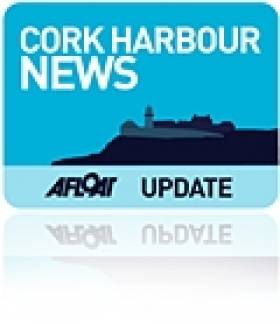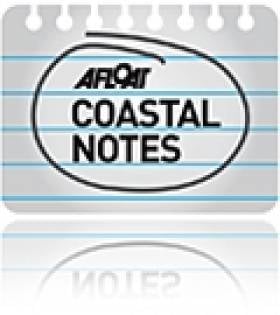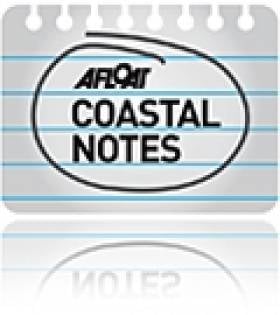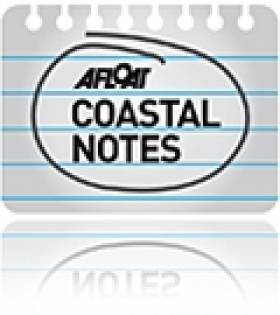Displaying items by tag: Gregg Bemis
#Lusitania - This week saw the centenary of the sinking of the Lusitania marked with commemorative events in Cork Harbour, including a ceremony in Cobh led by President Michael D Higgins and a cruise call by the Cunard Line's Queen Victoria as part of its 'Lusitania Remembered' voyage.
New sonar imagery showing the full extent of the wreck site off Kinsale was also revealed this week, displaying its current condition on the sea floor in greater detail than ever.
A hundred years after it slipped below the waves, the ill-fated liner is only "beginning to reveal its wounds, scars and perhaps its secrets, and may continue to do so for many years to come," according to Government officials.
One man who's long hoped for such secrets to be revealed is the wreck's owner Gregg Bemis, who sent a personal tribute to be delivered instead of attending the official commemoration.
The multi-millionaire American businessman is currently at odds with the State over what he describes as "spiteful" the strict licensing rules imposed on his long-planned return dive to the wreck.
Bemis intends to disprove the findings of National Geographic's 2012 documentary on its so-called 'dark secrets', in his belief that there was more to the second explosion that sealed its fate than a damaged boiler.
His story is the subject of a detailed profile in the latest Fortune magazine. And more recently he wrote a scathing piece in The Irish Times, highlighting the "double standard" in the lack of public expenditure on researching shipwrecks in relatively shallow waters such as the Lusitania and the Estonia, which sank in the Baltic in 1994, compared to the multiple millions spent over many years on plane crash sites to determine their cause.
Bemis had more to say to The Irish Times' Lorna Siggins about his deep research into the Lusitania controversy, and whether it really did carry a clandestine arms and munitions shipment which may have made it the target for the German U-boat that blasted its hull.
While the owner did not travel to Cork Harbour himself, diver Eoin McGarry went in his stead to place Bemis' tribute plaque with the names of the hundreds who died in the tragedy, as well as a single red rose, near the remains of the ship's bridge.
McGarry – who has descended to the wreck more than anyone else – willingly paid the harsh decompression penalties to return to what's regarded as the Everest of diving, according to fellow diver Tim Carey.
"The first glimpse of the vessel is a huge feeling of exhilaration," Carey writes in the Irish Independent, adding that "swimming around the wreck is a very touching experience and is like transcending time".
However, he also warns that "diving the wreck over a ten-year period has shown me one inescapable fact - the wreck is constantly corroding and collapsing further and is suffering a lot of damage from fishing nets."
Which means that the preservation of its remaining artefacts, if not the revelation of its deepest secrets, must be secured before it's too late.
State Rules Hindering Lusitania Return Dive Says Wreck Owner
#Lusitania100 - The multi-millionaire businessman owner of the Lusitania wreck claims the State has left the site vulnerable to treasure hunters while preventing his own return dive to recover artefacts.
As RTÉ News reports, Gregg Bemis described as "spiteful" the strict rules imposed on his planned return to the wreck to retrieve objects of value and historical importance.
He also aims to disprove the findings of a 2012 documentary on the fate of the Cunard liner that was torpedoed by a German U-boat off the Old Head of Kinsale on 7 May 1915 – which claimed a second explosion on the ship reported at the time came from a boiler in the vessel's bowels, and not from its alleged munitions cargo.
But Bemis says Government officials "are so glib and innocent sounding like they walk on water, but they add all these restrictions on and throw them at me so they interfere and impede."
That's despite securing the endorsement from then Heritage Minister Jimmy Deenihan for a return dive two years ago.
What's more, Bemis' previous dive team leader Eoin McGarry fears the wreck site may already have fallen victim to pirates seeking artefacts such as the ship's steam whistle and the captain's personal safe.
However, a statement from the Government said the conditions of Bemis' licence "are no more onerous than is absolutely necessary to protect a wreck of this global significance."
The controversy comes as Cork prepares to recognise the centenary of the Lusitania disaster, already the subject of a museum exhibition in Liverpool.
RTÉ News has more on the story HERE.
#Lusitania - The owner of the Lusitania may get his wish for a return dive to the wreck of the ill-fated passenger liner after the Minister for Heritage endorsed plans for a fresh investigation into its sinking.
The Irish Times reports that Minister Jimmy Deenihan has "agreed to a broad set of exploration objectives" with Gregg Bemis, the American millionaire businessman who has had had a financial interest in the wreck since 1968, and sole ownership since 1982.
As previously reported on Afloat.ie, Bemis had been seeking permission from the Government since last September after disputing the findings of a documentary made during an expedition to the wreck in the summer of 2011.
The cruise liner - a rival of the Titanic in its day - was hit by a torpedo from a German U-boat off the Old Head of Kinsale on 7 May 1915, during the First World War, sinking in just 20 minutes and taking 1,198 lives.
However, there have long been accounts of a second explosion on the sinking vessel before it was submerged - leading some to believe that it was carrying Allied munitions in its cargo.
Bemis staged his previous expedition in a bid to discover once and for all what really happened to the Lusitania. But last year he said that the National Geographic documentary team behind 'Dark Secrets of the Lusitania' used "insufficient data" to conclude that the second explosion was from a boiler in the bowels of the ship.
The businessman's ambitions had also been thwarted by a long-running dispute with Leinster House over the State's heritage rights to the wreck site and the effect of exploration on its condition.
Minister Deenihan is reviewing a new licence application that would involve numerous dives to the wreck over the next three years, including the centenary year of the Lusitania's demise in 2015.
The Irish Times has more on the story HERE.
Lusitania Owner Rejects TV Doc Findings, Wants Second Dive
#LUSITANIA - The millionaire owner of the Lusitania shipwreck has rejected the findings of the recent TV documentary investigating the mystery of its sinking.
The Irish Independent reports that Gregg Bemis is seeking permission from the Government to mount another dive to the wreck site to "pursue the truth".
On 7 May 1915 the cruise liner RMS Lusitania was hit by a torpedo from a German U-boat off the coast of the Old Head of Kinsale in Co Cork, with the loss of 1,198 lives.
A second explosion was reported minutes later, and within 20 minutes the vessel was underwater. Only 761 people survived.
Last summer Bemis launched what was expected to be the last dive expedition to find out what really happened to the former Cunard passenger liner.
However, Bemis argues that the National Geographic documentary team behind 'Dark Secrets of the Lusitania' used "insufficient data" when they concluded that the second explosion on the vessel following a torpedo strike was from a boiler blowing up in the bowels of the ship.
He remains convinced that a secret cargo of Allied munitions was responsible for the devastating explosion that sealed the ship's fate.
"They did not have all the information they should have had," said Bemis. "They used a computer analysis to get their theory and a computer is only as good as the garbage you put in. You put garbage in, you get garbage out."
The American said only a second dive with complete access to the hull could uncover what he believes really happened - a project he hopes will take place before the Lusitania centenery.
Event to Mark Worldwide Release of 'Dark Secrets of the Lusitania'
#LUSITANIA - M3 TV Productions will be holding a special event in the Port of Cork on 14 September to mark the worldwide release of Dark Secrets of the Lusitania.
The TV documentary, which premiered last month on the National Geographic Channel, follows what might have been the last expedition to the wreck of the ill-fated cruise liner.
On 7 May 1915 the passenger liner RMS Lusitania was sunk by a torpedo from a German U-boat off the coast of Cork, with the loss of 1,198 lives. But theories abound that there was more to the disaster than the torpedo strike, and that the ship's cargo hold contained precious art and illegal munitions.
The documentary attempts to uncover what really happened, using the latest submersible technology to see further into the shipwreck than ever before.
Gregg Bemis, the US owner of the shipwreck of the former Cunard cruise liner, will be flying in for the worldwide launch event.
Other guests include representatives from the marine industry, Minister for Arts & Heritage Jimmy Deenihan, Sean Kelly MEP, Senator Deirdre Clune and representatives from the Irish Coast Guard and Naval Service.
Actors will be dressed in First World War period costume to create a special atmosphere on the evening. The Irish Examiner will also display a digital exhibition of photos on the Lusitania, while UCC's Professor Dermot Keogh will give anoverview of that tumultuous period of world history.
New TV Documentary on Dark Secrets of the Lusitania
#LUSITANIA - A new TV documentary on the National Geographic Channel follows what might be the last expedition to the wreck of the Lusitania, in a bid to get to the bottom of the century-old mystery surrounding the ill-fated vessel.
On 7 May 1915 the passenger liner RMS Lusitania was sunk by a torpedo from a German U-boat off the coast of Cork, sending 1,198 lives to their doom.
But theories abound that there was more to the disaster than the torpedo strike, and that the ship's cargo hold contained precious art and illegal munitions.
Dark Secrets of the Lusitania attempts to uncover what really happened, using the latest submersible technology to see further into the shipwreck than ever before.
As previously reported on Afloat.ie, Gregg Bemis - the elderly American who owns the wreck of the former Cunard cruise liner - hoped last year to discover once and for all what secrets the ship really holds in what may be the last major dive to the wreck site.
Dark Secrets of the Lusitania premiers on Sunday 15 July at 7pm on the National Geographic Channel, available on Sky and UPC.
Lusitania Divers Recover a Number of Items
Divers at the wreck of the Lusitania have recovered important items from the ill-fated cruise liner, The Irish Times reports.
The haul includes a bronze telemotor (part of the ship's steering mechanism), a telegraph that assisted in navigation, and a number of portholes.
It is hoped that some of these might shed some more light on how the ship was lost off the Cork coast, after she was torpedoed by a German U-boat in 1915.
The items are currently being held by Customs and Excise under the 1993 Salvage and Wreck Act until title can be established.
As previously reported on Afloat.ie, Lusitania owner Gregg Bemis is currently mounting what might be the final major dive expedition to the wreck site.
The Irish Times has more on the story HERE.
What Happened to the Lusitania?
American Gregg Bemis is headed to Ireland for what may be the last major dive to the wreck of the Lusitania.
Bemis, who owns the wreck of the former Cunard cruise liner torpedoed off the Cork coast in 1915, told The Irish Times that hopes to discover once and for all what was in the cargo hold of the ship - and give an answer to rumours that precious art and munitions were part of the manifest.
The millionaire has fought with the Irish State over the rights to the wreck site, to which he has dived twice before, but now he has full licence and access to the latest technology to unveil the Lusitania's deepest secrets.
The Irish Times has more on the story HERE.




































































